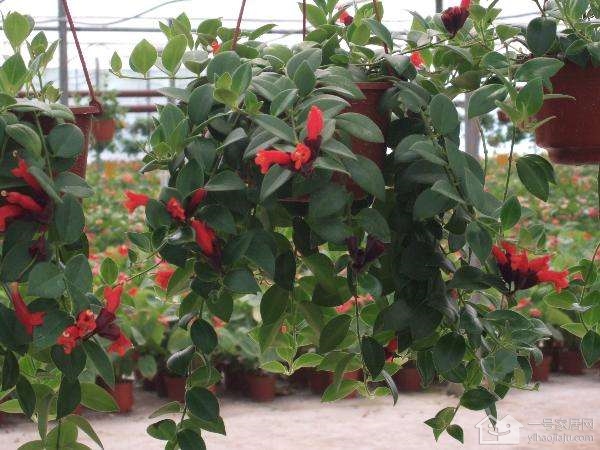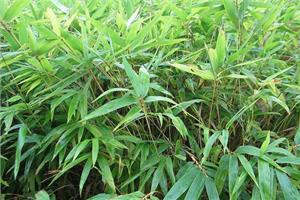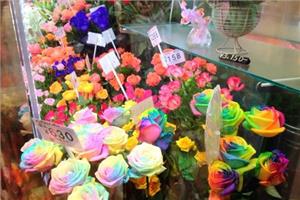You don't have to buy lipstick anymore when you grow lipstick.
Carthamus tinctorius is an excellent hanging plant in recent years, and its flowers and leaves have high ornamental value. As a small indoor foliage and flowering plant, it has beautiful plant shape, luxuriant stems and leaves, and colorful flowers, which can be placed in several cases or can be watched overhanging. It is a fashionable product for families to grow flowers. Now, let's take a look at the knowledge of saffron.

I. introduction of lipstick
Lipstick stem drooping up to about 1 meter, lipstick thick green leaves coupled with bright red and strange Corolla, quite loved by people. The flowering of lipstick is mainly in summer. Saffron is an epiphytic evergreen vine. Epiphytic, often planted in a suspended basket. The stem is about 1 meter long. Flowers paired at the tip of branches, shortly pedicellate, Corolla tube-shaped, bright red. Lipstick flowers and leaves opposite, leaf blade ovate, elliptic or Obovate, leathery and slightly fleshy, long 4.5cm, wide 3cm, entire, midvein obvious, lateral veins hidden, leaf surface dark green, back light green. Flowers axillary or apically clustered. Flowers paired on top of branches, shortly pedicellate, Corolla red to red-orange, ca. 6.5cm. Calyx tube-shaped, black-purple tomentose, until long to about 2cm, Corolla from the calyx mouth grow, tube-shaped, bright red, like lipstick general name. Lipstick stem drooping up to about 1 meter long, lipstick thick green leaves coupled with bright red and strange Corolla, quite popular lipstick flowering mainly in summer.
Second, the cultivation techniques of saffron.
1. Cultivation and management
Lipstick prefers a semi-overcast environment with warm and bright light. Lack of light, it is easy to cause branches to grow and not easy to blossom; too strong light, the leaves will become reddish brown. Family cultivation of saffron is most suitable for hanging about 1 meter away from the south window. The pot soil is slightly acidic, and the pot culture soil made of peat soil, sand and vermiculite can be added with appropriate amount of calcium superphosphate. It can also be cultivated with 8 parts of rotten leaf soil mixed with 2 parts of coarse sand, and with mature cow dung and horse dung mixed with 30% coarse coal furnace ash. In hot summer, it can be placed under the outdoor shade or in a ventilated place under the shade of trees, with a shade of about 50%. Families living in buildings can hang pots under the scaffolding of the balcony, shaded by bamboo curtains, or hang pots where the inner side of southward doors and windows scatter enough light.
Saffron needs less fertilizer at ordinary times, and it is better to apply some rotten liquid fertilizer every two weeks. When putting on the basin, an appropriate amount of livestock hoof horns and broken bones can be added as base fertilizer to make it grow well. For example, 0.1% solution of potassium dihydrogen phosphate and 20 times solution of rotten fish visceral water and bone water can promote the opening of autumn flowers. After putting on the basin, it is necessary to keep the basin soil moist and should not be too wet, especially when there is poor ventilation on the basin, the root system is easy to rot or cause fallen leaves to often spray water mist on the leaves, keeping the air humidity about 80%. Avoid the wind blowing the branches, so as not to break the drooping stems along the flowerpot. The weather is getting colder and colder in autumn, so the amount of water and fertilizer should be reduced gradually. The basin soil should be slightly dry in winter, except that some fertilizer liquid containing a little more phosphorus should be properly applied before the pregnant bud blossoms, generally speaking, there should be less fertilization or no fertilization.
two。 Temperature management
The growth temperature of Carthamus tinctorius is 18-30 ℃, and the optimum temperature is about 25 ℃. The cold tolerance is poor. The overwintering temperature should be above 12 ℃. If it is found that the redness of lipstick leaves is mainly caused by too low room temperature or too strong light, the room temperature should be increased in time. If the room temperature is too low, it will cause the leaves to fall off and the branches to dry up. Lipstick flowers are not cold-resistant and need to be indoors in winter. Saffron is not strict with the air humidity, and the indoor air is not too dry to adapt. The suitable temperature for growth should be about 25 ℃, and the overwintering temperature should be above 12 ℃.
If it is found that the lipstick leaves turn red, if the light is too strong or the room temperature is too low, the room temperature should be raised in time. If the room temperature is too low, the leaves will fall off and the branches will dry up. If the room temperature is suitable, the florescence of the saffron will be concentrated from December to February of the following year, when less nitrogen fertilizer should be applied, the indoor light intensity should be increased, and the lower room temperature should be controlled, which can promote the flowering of the carrot. After the winter flowering, the stump stems that have flowered should be cut off in time, which can save the consumption of nutrients and promote new shoots, so as to make them blossom.
3. Cultivation substrate
The pot substrate is loose and fertile slightly acidic rotten soil. The pot culture soil made of peat soil, sand and vermiculite can be used, and appropriate amount of calcium superphosphate is added as base fertilizer. 8 parts of rotten leaf soil mixed with 2 parts of coarse sand can also be used as substrate, and mature cow dung and horse dung can also be cultivated with 30% coarse coal furnace ash. Saffron needs less fertilizer in the process of growth, and an appropriate amount of livestock hoof horns and broken bones can be added as base fertilizer to make it grow well.
Lipstick flower
4. Watering and fertilizing
Cultivated lipstick flowerpot soil should always be kept moist, but avoid stagnant water in the pot, especially when there is poor ventilation on the pot, so as not to cause root rot, and the pot soil should be slightly dry in winter. In summer, fog water should be often sprayed on the leaf surface to increase the humidity of the leaf surface and the surrounding environment to facilitate its growth. Safflower needs less fertilizer at ordinary times, and it is better to apply some rotten liquid fertilizer every two weeks. Add appropriate amount of horns of livestock hooves and broken bones as base fertilizer when putting on the basin.
During the vigorous growth period, saffron can be treated with mature organic fertilizer once every 15-20 days, and more phosphorus and potassium fertilizer can be applied after summer. For example, 0.1% solution of potassium dihydrogen phosphate and 20 times solution of rotten fish visceral water and bone water can promote the opening of autumn flowers. When the weather is getting cooler and colder in autumn, the amount of water and fertilizer should be reduced gradually. In addition to the proper application of liquid fertilizer with a little more phosphorus before the bud blossoms, there should be less fertilization or no fertilization in general. Under suitable conditions such as room temperature, the florescence of saffron will be concentrated from December to February of the following year, and less nitrogen fertilizer should be applied at this time.
5. Pruning and reproduction
After the winter flowering, the stumps that have flowered should be cut off in time and the overlong drooping branches should be trimmed once, so as to save the consumption of nutrients and promote the development of new branches, and more flowers will bloom in the coming year.
The above is the knowledge of lipstick. I hope I can help you.
It can save the consumption of nutrients and promote the development of new branches, and more flowers will bloom in the coming year.
The above is the knowledge of lipstick. I hope I can help you.
Related
- Wuhan Hospital Iron Tree Blooming Result Was Instantly Frightened by the Gardener Master
- Which variety of camellia is the most fragrant and best? Which one do you like best?
- What is the small blue coat, the breeding methods and matters needing attention of the succulent plant
- Dormancy time and maintenance management of succulent plants during dormancy
- Minas succulent how to raise, Minas succulent plant pictures
- What are the varieties of winter succulent plants
- How to raise succulent plants in twelve rolls? let's take a look at some experience of breeding twelve rolls.
- Attention should be paid to water control for succulent plants during dormant period (winter and summer)
- Watering experience of twelve rolls of succulent plants
- Techniques for fertilizing succulent plants. An article will let you know how to fertilize succulent plants.



